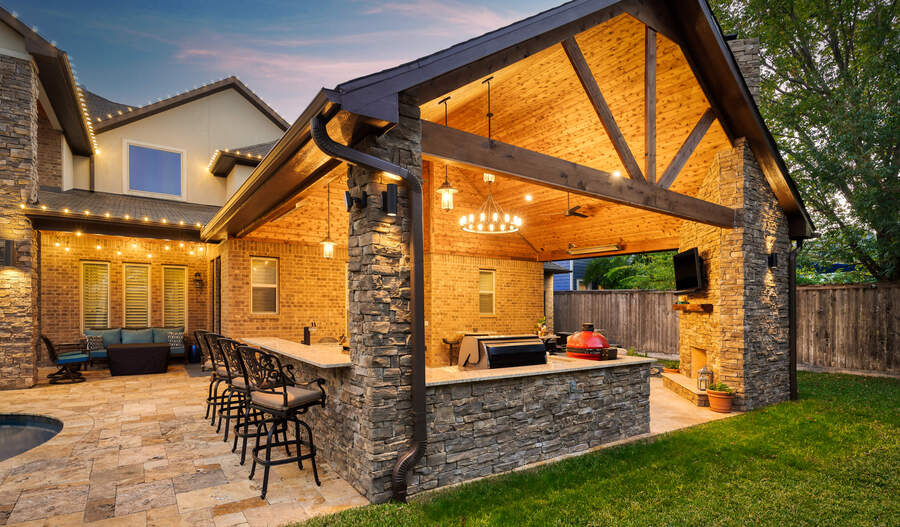Keeping the environment in mind is a great way to reduce your carbon footprint. One way of doing this is by installing a patio cover. Patio covers are a great way to provide shade and protection for your outdoor space while reducing your carbon footprint. Patio covers come in a variety of styles and materials, so you’re sure to find one that fits your needs. Installation and energy-efficient features vary, so you’ll want to consider your specific needs when making a decision. This article will discuss the benefits of patio covers, the types of patio covers, installation considerations, energy-efficient features, and maintenance and care tips.
The Benefits of Patio Covers
Installing a patio cover not only adds a stylish touch to your outdoor living space, but can also help lower your energy costs. By shading your patio from the sun, you can reduce the amount of heat transferred into your home, leading to decreased energy usage and lower energy bills. Additionally, patio covers provide a natural cooling effect by blocking the sun’s direct rays and allowing more indirect sunlight to enter the patio.
This process helps regulate the temperature in your home and can reduce the need for air conditioning, leading to lower energy consumption and a smaller carbon footprint. Patio covers also provide protection from the elements, such as rain and hail, helping to reduce maintenance costs. Overall, patio covers offer many benefits that can help reduce your carbon footprint and save you money in the long run.
Types of Patio Covers
You can significantly impact your environment by selecting the correct type of patio cover! Patio covers are a great way to reduce your carbon footprint, often made from sustainable materials such as wood or aluminum. When properly treated and maintained, wood patio covers can last many years and provide an attractive, natural look. Aluminum patio covers are also a great option, as they are lightweight, durable, and easily recycled. Additionally, many patio covers are designed to provide shade from the sun, helping to reduce energy costs and keep your home cooler in the summer.
No matter which type of patio cover you choose, you can rest assured that you’ll be helping to reduce your carbon footprint. With the right selection, you can enjoy the benefits of having a patio cover while also reducing your environmental impact. Taking the time to research and understand the types of patio covers available can help you make an informed decision and find the right cover for your home.
Installation Considerations
When installing a patio cover, there’s much to consider, from the type and material to the size and shape. Finding the right balance between style and function is important to ensure the patio cover reduces your carbon footprint. For example, if you choose a larger patio cover than you need, the extra material is an unnecessary waste of resources. Alternatively, if you opt for a smaller patio cover, it may not provide enough coverage to reduce your carbon footprint effectively.
Furthermore, you should also consider the type of material you use for your patio cover. For instance, using a lightweight material such as canvas can be more energy-efficient than using a heavier material like wood. Additionally, you may want to look for materials that are made from recycled or sustainably sourced materials, as these will help reduce your carbon footprint even further.
Energy-Efficient Features
Adding energy-efficient features to your patio cover can help it better serve its purpose while also conserving resources. It’s important to consider the materials used to construct the cover and the type of insulation used. For example, using insulated panels made from materials like foam, fiberglass, or insulated vinyl will help keep the air inside the patio cover cool in summer and warm in winter. Additionally, you can opt for a patio cover that utilizes a passive cooling system, such as a solar panel-powered fan, to help draw in cool air without using electricity.
Installing skylights or windows in your patio cover can also help reduce your carbon footprint by allowing natural light in, reducing the need for artificial light sources. For example, using windows with a low-E coating can help reflect heat and keep the area cooler. Lastly, you can opt for a patio cover with a green roof, which is covered with vegetation, to reduce the energy needed for cooling and heating.
Maintenance and Care Tips
Taking proper care of your patio cover will ensure it lasts for years. Inspecting your patio cover regularly is important, looking for any signs of damage or wear and tear. If you notice any wear and tear, you should repair it promptly to prevent further damage. Additionally, you should clean your patio cover every few months to prevent dirt and debris build-up. For best results, use a mild detergent and a soft brush. Make sure to rinse the cover with clean water after each cleaning to avoid any soap residue. Finally, if your patio cover is not made from a weather-resistant material, you should cover it with a tarp during inclement weather to protect it from the elements. These simple maintenance and care steps will help you reduce your carbon footprint and keep your patio cover in top condition for years.
Key Takeaways
- Energy Savings: Installing a patio cover can help reduce your carbon footprint by providing natural shade, which can reduce the need for air conditioning and lower energy consumption. By blocking direct sunlight, a patio cover helps keep your home cooler, reducing the need for artificial cooling.
- Sustainable Materials: Choose eco-friendly materials for your patio covers, such as sustainably sourced wood or recycled materials. These options have a lower environmental impact and contribute to reducing your carbon footprint.
- Rainwater Collection: Consider incorporating a rainwater collection system into your patio cover design. This allows you to collect and reuse rainwater for watering plants, reducing the need for additional water consumption. It helps conserve water resources and minimizes your environmental impact.

